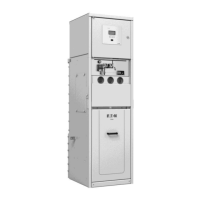3. Remove the handle and check that the position
indicator (9) of the change-over switch indicates the
busbar position.
4. Turn the selector anti-clockwise until the switch control
point (5) is revealed.
5. Place the operating handle with the arrow pointing up
in the switch control point (5). Switch the cable to
busbar by turning the handle clockwise as far as it will
go, i.e. to approximately 190
0
. The mechanism will
switch audibly at that point.
6. Remove the handle and check that the position
indicator (4) of the switch indicates the ON position.
In the viewing window the closed operating position is
also visible (see Figure 4-3).
7. Turn the selector (7) back to the central position, both
openings (5) and (8) will then be covered.
Procedure for switching off the operating position
1. Press the opening button (3).
2. Check that the position indicator (4) of the switch
indicates the OFF position.
In the viewing window the opened operating position is
also visible, see Figure 4-4.
3. Turn the selector (7) back to the central position, both
openings (5) and (8) will then be covered.
Procedure for switching the operating position to
the neutral position
1. Turn the switch off with the opening button (3). Check
that the position indicator on the switch (4) indicates
the OFF position.
2. Turn the selector (7) clockwise so that the control
point for the change-over switch (8) is revealed.
3. Place the operating handle with the arrow pointing up
in the control point of the change-over switch (8). Turn
the change-over switch in earthed position by rotating
the handle190
0
clockwise until you start to feel some
resistance. Additional resistance will be noticeable
towards the end of this rotation. The handle cannot be
removed until earthing position of the change-over
switch has been reached.
4. Remove the handle and check that the position
indicator (9) of the change-over switch indicates the
earthed position.
5. Turn the selector (7) back to the central position, both
openings (5) and (8) will then be covered.

